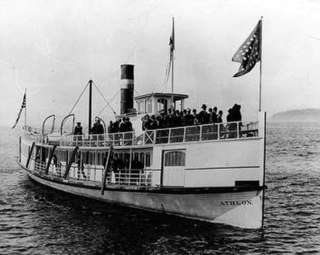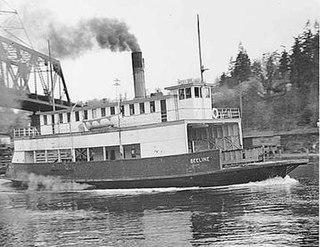| | |
| Successor | Puget Sound Navigation Company |
|---|---|
| Headquarters | Seattle, Washington |
The La Conner Trading and Transportation Company was founded in the early 1900s by Joshua Green and others, to engage in the shipping business on Puget Sound.
| | |
| Successor | Puget Sound Navigation Company |
|---|---|
| Headquarters | Seattle, Washington |
The La Conner Trading and Transportation Company was founded in the early 1900s by Joshua Green and others, to engage in the shipping business on Puget Sound.
The La Conner Trading and Transportation Company was formed in the early 1890s by four officers of the steamer Henry Bailey, Joshua Green, purser, Sam Denny, master, Peter Falk, mate, and Frank Zickmund, second engineer. Green persuaded the others to leave the Henry Bailey and go into business for themselves, by purchasing the freight steamer Fannie Lake and a scow, for a total investment of about $5000. Green at the time had savings of only about $250 and the others had very little. However they were able to secure loans of $1,250 each, secured by the steamer and the scow, from banker Jacob Furth and the Puget Sound National Bank. [1]
Running in the freight business, the company was not competing for passenger fares. Instead the new firm's main competition came from George T. Willey, a Seattle hay and grain merchant. As business increased, the four partners bought another steamer, the Annie M. Pence . Willey then joined with the four original partners and they incorporated the business as the La Conner Trading and Transportation Company. [1]
The company suffered business reverses. In April 1893, Fannie Lake was destroyed by a fire that started in a cargo of hay. The vessel was valued at $5,000 and insured for only $4,000. [2] An economic depression called the Panic of 1893 hit the company hard, and things got worse when the company's other hay steamer, the uninsurable Anna M. Pence, was also destroyed by fire. [1]
Green had the idea to purchase a new boat, which he would name after the builder, which he concluded would save up to $2,000 off the price of the boat. Builders were willing to build for less if the completed vessel were to be named after the builder, as it would function as a floating advertisement. In this way, the company acquired the T.W. Lake built by the shipbuilder of the same name. The Lake was purpose-built to move freight, and included a winch to lift cargo up to piers, regardless of the state of the tide. [1]
Following the purchase of the Lake, the company continued to expand, adding the steamers E.D. Smith, Utopia, George E. Starr, and the sternwheelers State of Washington, Fairhaven and La Conner to the roster. The company also built the City of Denver for Colorado investors. When the Colorado interests defaulted on payment, the company took over the boat and added to their fleet. [1]
The company had also expanded into the passenger business, buying the fast steamer Inland Flyer and putting that vessel on the lucrative Seattle – Bremerton run in opposition to the Athlon, owned by H.B. Kennedy. [1]
By 1902, Joshua Green had bought out Sam Denny's shares, and some of the stock of George T. Willey. Willey then sold the rest of his shares to the Alaska Steamship Company, of which Charles E. Peabody was president. This gave Peabody and Alaska Steam a controlling interest in La Conner Trading. Alaska Steam ran ships to Alaska and also had a large fleet of inland vessels operating on Puget Sound. The Puget Sound operations were conducted under the name of the Puget Sound Navigation Company. With the acquisition of La Conner Trading, PSN was almost doubled in the size of its fleet. After a period of transition, the La Conner company was effectively merged into the reorganized Puget Sound Navigation Company, which in later years came to dominate Puget Sound passenger and ferry business as a near-monopoly. [1]

Lake Washington steamboats and ferries operated from about 1875 to 1951, transporting passengers, vehicles and freight across Lake Washington, a large lake to the east of Seattle, Washington. Before modern highways and bridges were built, the only means of crossing the lake, other than the traditional canoe or rowboat, was by steamboat, and, later, by ferry. While there was no easily navigable connection to Puget Sound, the Lake Washington Ship Canal now connects Lake Washington to Lake Union, and from there Puget Sound is reached by way of the Hiram M. Chittenden Locks.

Athlon was a typical passenger steamboat of the Puget Sound Mosquito Fleet.

The steamboat Monticello (2) operated in the early 1900s as part of the Puget Sound Mosquito Fleet. The vessel went through several reconstructions and remained in service until 1962, when she was lost in Alaska waters. Her later names were Penaco and Sea Venture. (This Puget Sound steamer should not be confused with the smaller Monticello, which also ran on Puget Sound, but was built in 1895 for Captain Z.J. Hatch of the Monticello Steamship Company.

The steamboat George E. Starr operated in late 19th century as part of the Puget Sound Mosquito Fleet and also operated out of Victoria, B.C. Geo. E. Starr also served for a time in California and on the Columbia River.

The steamboat Rosalie operated from 1893 to 1918 as part of the Puget Sound Mosquito Fleet, also operating out of Victoria, B.C. In 1898, Rosalie went north with many other Puget Sound steamboats to join the Klondike Gold Rush.

Joshua Green was an American sternwheeler captain, businessman, and banker. He rose from being a seaman to being the dominant figure of the Puget Sound Mosquito Fleet, then sold out his interests and became a banker. Living to the age of 105 and active in business almost to the end of his life, he became an invaluable source of information about the history of Seattle and the Puget Sound region. According to Nard Jones, Green was one of the city of Seattle's last fluent speakers of Chinook Jargon, the pidgin trade language of the Pacific Northwest.

T.W. Lake was a steamboat that ran on Puget Sound in the early 1900s. This vessel was lost with all hands on December 5, 1923 in one of the worst disasters of the Puget Sound Mosquito Fleet.
Annie M. Pence is a steamboat that ran on Puget Sound in the early 1890s.

Henry Bailey was a sternwheel steamboat that operated on Puget Sound from 1888 to 1910. The vessel was named after Henry Bailey, a steamboat captain in the 1870s who lived in Ballard, Washington.

Lady of the Lake was a wooden steamboat that operated on Puget Sound from 1897 to 1903. Following a fire in 1903, the vessel was rebuilt as the tug Ruth.

Otter was a wooden sternwheel steamboat that was used in Puget Sound and briefly on the Columbia and Stikine rivers from 1874 to 1897.

Teaser was a steamboat which ran on the Columbia River and Puget Sound from 1874 to 1880.
Comet was a sternwheel steamboat that ran from 1871 to 1900 on Puget Sound and rivers flowing into it, including the White and Nooksack rivers.

Alice Gertrude was a wooden steamship which operated on the Strait of Juan de Fuca and Puget Sound from 1898 to January 1907, when she was wrecked at Clallam Bay in Washington.

Florence K was a steamboat that was operated on Puget Sound from 1903. This vessel was later renamed Gloria and was rebuilt as a steam ferry and renamed Beeline.

Inland Flyer was a passenger steamboat that ran on Puget Sound from 1898 to 1916. From 1910 to 1916 this vessel was known as the Mohawk. The vessel is notable as the first steamer on Puget Sound to use oil fuel. Inland Flyer was one of the most famous vessels of the time on Puget Sound.

General Miles was a steamship constructed in 1882 which served in various coastal areas of the states of Oregon and Washington, as well as British Columbia and the territory of Alaska. It was apparently named after US General Nelson A. Miles.

Kirkland was a sidewheel steamboat that ran on Lake Washington from 1888 to 1898.

Sol Duc was a steamship which was operated on northern Puget Sound from 1912 to 1935, chiefly on a route connecting ports on the Olympic Peninsula with Seattle. During the Second World War (1941–1945) Sol Duc served as a barracks ship.

Atlanta was a steamboat built in 1908 at Houghton, Washington which served on Lake Washington and Puget Sound until 1938, when it was converted into a diesel-powered houseboat.